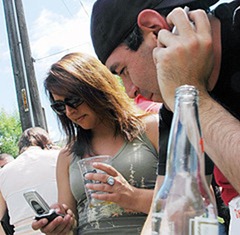Smartphones and social media make it possible to connect with long-distance family members and long-lost loves, but is it really bringing people closer together? Smartphones make communication across distances so much easier, but a lot of day-to-day interactions with people have changed dramatically.
The Most Popular Gadget: Good or Bad?

Technology is an ever-changing monster, but few items have linked the human race together as well as cell phones. If you feel like everyone’s got one, you aren’t far from wrong. One 2006 study shows that there are more mobile phones in Britain than there are people. They’re so ubiquitous, they're on sale at big box retailers and even convenience stores – like packs of gum.
Mobile phones could be the most popular gadget ever invented. More life-changing than the television set, used more than the household toaster, and upgraded even more often than laptops, mobile phones really are everywhere. Since so many people now use mobile phones, it would seem to follow that phones bring us all closer together. There’s plenty of evidence to support that theory.
Forging New Connections, Staring at Screens Instead of Faces
 Cell phones have blown open doors that were once closed, providing opportunity to those who wouldn’t have had it otherwise. Thanks to cell phones, more professionals can work remotely instead of being stuck in an office. Now, anyone with an app and the right skills can start a business affordably. Cheap cell phone plans give birth to entrepreneurs, but these savvy business professionals may become faceless to their clients and partners. When you're separated by screen, business definitely isn't personal.
Cell phones have blown open doors that were once closed, providing opportunity to those who wouldn’t have had it otherwise. Thanks to cell phones, more professionals can work remotely instead of being stuck in an office. Now, anyone with an app and the right skills can start a business affordably. Cheap cell phone plans give birth to entrepreneurs, but these savvy business professionals may become faceless to their clients and partners. When you're separated by screen, business definitely isn't personal.
Now, it’s possible to communicate with someone on the other side of the world in an instant. You can use your cell phone to play a game of chess against someone in Norway without ever leaving the couch. It’s truly amazing. But like everything else, all this tech also has a down side. It's so easy to sit on the couch and connect with strangers, you may be less inclined to meet people in a real-world environment.
Nice to Meet You...Sorry, I was Talking to Your Cell Phone

There’s a dark side to the abundance of cell phones, too. That working professional who uses a mobile phone to stay in touch with the office might actually work more than they would otherwise. Now work time has a way of creeping into personal time all the time. More professionals are spending less time with their families and more on their gadgets.
That mother who stays with the kids no longer has a lot of reason to get out of the house. She can use her cell phone to play games, connect with old friends, and stay in touch with family members. So she stays in. And while those are great benefits her cell phone provides, staying in so much isn't good for her. Everyone has to escape the house sometime, get out into the world, and interact with others. But if you try, you might find a cell phone instead of a face looking back at you.
Day-to-day interactions have been dramatically altered by cell phone use. Cheap cell phone plans and deep discounts on mobile devices makes it possible for people from all economic backgrounds to own these gadgets. And when you own one, you use it. So instead of talking to that stranger in line at the store, you’re on the phone. Instead of asking for directions, you ask your phone. Now, people are more inclined to turn to technology than to each other.
According to estimates, around 93 percent of Americans use cell phones or wireless devices of some sort. At least one-third of them use smartphones that allow them to get access to the Internet as well. Shockingly, almost 2 trillion text messages were sent from June 2009 to June 2010. That doesn’t leave a lot of time for meeting new people, randomly chatting with strangers, or staring someone in the eye. The numbers seem to show that social media, smartphones, and all these devices might be making people less social with each other.
Breaking the Cycle
Many have theorized that email and social media have eliminated face to face communication, and statistical evidence would seem to back up this claim. But mobile technology does make us more connected to each other, and gives us a lot more opportunities to make those connections. Technology is a great thing when it’s used the right way. Use yours to become more social and get closer to those who are in your life.
- Email: Keep using email to stay connected with friends and business associates. It’s a handy tool. But you should also use it to schedule face-to-face meetings and send out invites to social gatherings. The next time you host an event, use your email contacts to broaden your social circle. Instead of using it as a tool to avoid interaction, use email to encourage it.
- Social media: Use your social media profiles not as a forum for preaching your beliefs or detailing the day-to-day humdrum of your life, but as a way to discover new friends. Find the music, television, books, and items you like on social media and see who else is on the list. Engage in discussions on these topics and make new friends.
- Discover: Get mapping apps and events apps that show you what’s happening in your local area and get out of the house more. Use your smartphone as a tool to discover new venues and events in your city or town and meet new people face-to-face. Cell phones are a great way to find social opportunities in the real world; put your energy into this instead of hiding in the virtual world.
Technology can bring us closer together, but only if we use it the right way and make an active effort to do so. Your cell phone is a wonderful tool for connecting or for avoidance, and you have to decide which it’s going to be.
Photo credits: Thomas Kohler, Mike Licht, Wonderlane
This is a guest article by DJ Miller, who is a graduate student at the University of Tampa. He is an avid gadget geek who spends most his time writing on anything tech related. In his spare time he likes to travel, play soccer, and watch movies. You can follow him on twitter @MillerHeWrote

Great post DJ! Especially love the last section on breaking the cycle... it is easy for most to fall into these internet connectivity issues, the hard part is breaking it.
ReplyDeleteGreat article! I think technology in a lot of ways makes us both connected and yet farther apart... we're connected constantly to the Internet and to eachother's phones/tablets/devices, yet that takes us farther apart from in person communication.
ReplyDeleteHi,
ReplyDeleteThis comment is unique in that I am 60 & have not yet felt the need for a cellphone.I've only used them twice when my wife was driving & she asked me to dial for her,I didn't know what to do. I think that cellphones are very good ,there are so many good reasons to have one,like if you live alone like I do now & you roll over with a stroke & have a hard time getting to a phone.I just don't feel like I need one yet,if it becomes cheaper maybe I will..To keep track of your kids its good but not if the kids live on the pc or cellphone 24/7.
I do wonder if the next generations will be less able to connect or look into the eyes of others & see into the soul a glimpse.
I'd hate to dictate to others on how to live their lives